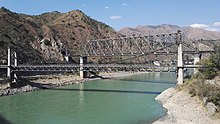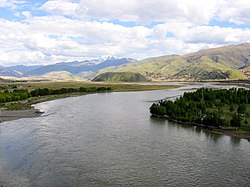|
Yalong River
 The Yalong River (Chinese: 雅砻江, p Yǎlóngjiāng, w Ya-lung Chiang, IPA [jàlʊ̌ŋ tɕjàŋ]), or Nyag Chu (Tibetan: ཉག་ཆུ་, z Nyag Qu), is a major tributary river of the Yangtze River in Southwest China. With a length of 1,571 km (976 mi), the Yalong River flows from north to south through the Hengduan Mountains in western Sichuan Province. CourseThe Yalong has its source in the Bayan Har Mountains on the Tibet–Qinghai Plateau in Chindu County, Yushu, Qinghai, where it is known as the Za Qu (Chinese: 扎曲).[4] Flowing southeasterly, the Yalong gradually turns south at Garzê and travels between the Shaluli Mountains to the west and the Daxue Mountains to the east.[5] The Yalong River channel runs through a deep gorge for much of its length south of Garzê. The southern Sichuan-Tibet Highway crosses the Yalong at Yajiang in the middle of the river's course. In Liangshan Prefecture, the river wraps 150 km (93 mi) around the Jinping Mountains creating the Jinping Bend.[5] Here, water from the Yalong River has been diverted under the mountains as part of the Jinping-II Dam hydroelectric project. The Yalong meets the main stem of the Yangtze (Jinsha) River in Panzhihua, Sichuan.[6] HistoryThe upper reaches of the Yalong have traditionally been inhabited by the Tibetan nomads of the historic region of Kham. The lower course of the Yalong is deeply incised and is not conducive to human habitation. The lower course of the Yalong was historically the western limit of Chinese influence in the region.[7] DamsSince the 1980s, the Yalong has been heavily developed for hydroelectric power.[7] A total of 23 dams are completed, under construction, or planned for the river. Those dams are listed below from downstream to upstream.[8][9]
References
External links
|
||||||||||||||||||||||||||||||||||||||||||||

